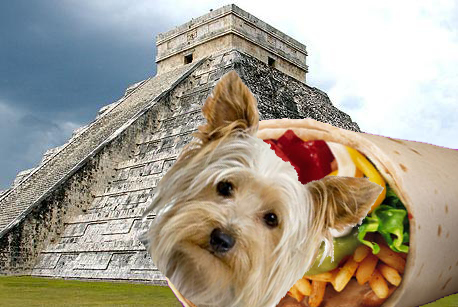By José C. Marmolejo
After analyzing countless varieties of tamales, I feel confident that I can design my own and so can you. There are certain rules to follow to ensure that they will come out all right: the type of masa to be used; the ratio lard/shortening to masa; and the cooking time. The rest is pure creativity—including a tamal without masa…
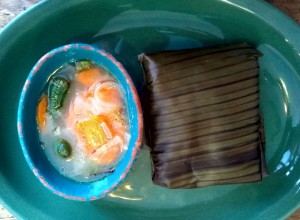
There are, however, some extraordinary tamales in Mexico that I wouldn’t dare to try to execute. Zacahuil would be one of them. These extraordinary tamales are from the Huasteca region, an area comprising the southern part of the state of Tamaulipas, north of the state of Veracruz, east of the state of San Luis Potosí and some areas bordering those states. These tamales are big: up to 6 feet long and 50 lbs. in weight. Needless to say that a project of this magnitude surpasses my ability to prepare and consume them, but something could be done; check the recipes below. You may begin to think that such a project needs the effort of a team and cannot be repeated often, and you are right. It takes a big family—perhaps some neighbors, too—and a special occasion to embark on such an adventure. But big families abound in Mexico and excuses to celebrate do as well: birthdays, baptisms, weddings, and of course the Day of the Death.
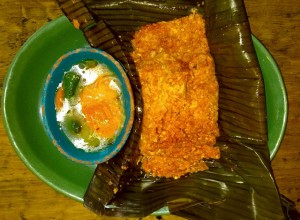
Zacahuil with jalapeños en escabeche
Corundas is another example of difficult tamales to execute. K’urhunda comes from the native language Purépecha in Michoacán and means tamal—again wrapped. These guys are small, they fit in the palm of your hand. The hard part is shaping them in the form of a pyramid by using the hands and the leaves of a fresh gramineae including corn.
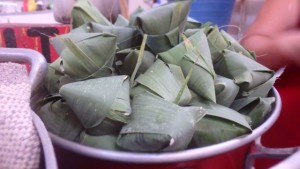
Uncooked corundas
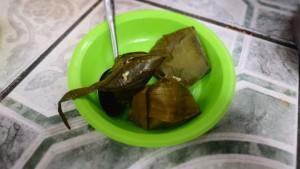
Finished corundas
One of my favorite “somebody make them for me please” tamales is Mucbil Pollo or Mukbil Pollo, where “muk” in the Mayan language means to bury. Since they are cooked in a pit they are also known as “Pib”. This is a family size tamal made around Hanal Pixián or Day of the Death in the Yucatán Península. The fact that a hole needs to be dug in the yard makes this tamal a real challenge to make but we can cheat and make it in the kitchen oven. It is however more delightful to visit the Yucatán Península the first week of November—when temperatures are civilized—and enjoy Mukbil pollo for several days from different vendors. Their fillings vary from chicken to turkey to pork or any combination thereof. That’s what I call a real food experience.
After reviewing steamed, roasted, baked and pit baked tamales, you may have in mind embarking yourself one of these weekends in a rare tamal producing adventure. For the brave cooks out there we provide below a couple of “doable” rare tamales recipes. Scale is the key. Attempt to make Zacahuil or Mucbipollo at home in a mini version, it will be fun. We’ve also included a recipe to prepare Champurrado, a chocolate flavored atole to accompany your home made tamales. Muy buen provecho!
Homemade Zacahuil
This is a small—big for some—and fun project with guaranteed reward.
Ingredients:
2 lbs. coarse corn masa
10 oz. of lard and/or shortening
½ teaspoon baking powder
2 oz. chile guajillo stemmed and seeded
1 oz. chile de árbol stemmed and seeded
1 medium size onion
2 to 3 garlic cloves
1 lb. of cooked chicken or pork shredded
The broth from where the chicken/pork was cooked
salt to taste
2 banana leaves
cooking cotton cord
1 ovenproof dish
Instructions:
Fry the chiles, onions, garlic, and salt lightly in a little lard or shortening. Once that has cooled off, put everything in a blender and add some broth to make a thick sauce. Reserve it. Mix the lard and shortening very well in two cups of hot water. Dispose of the water that did not mix with the fats and add the rest to the dough little by little as you mix constantly. Add the baking powder and salt and mix. The secret of spongy tamales starts with mixing the lard and shortening perfectly and later mixing the fats thoroughly with the dough. Every cubic inch of dough should have the same amount of fat. Add pork stock to the dough to make it manageable. To test the dough, make little balls of it randomly picked and put them in a glass of water; they should float. If they sink keep mixing. In a large container, mix the sauce and the shredded chicken or pork with the masa to a uniform blend. If needed, add some broth to the masa to make it pliable. Soften the banana leaves by passing them several times over a flame. This will make them pliable and easy to manage while wrapping the tamale. Place two strings of cord forming a cross on the bottom of the ovenproof dish, long enough to tie up the tamale. Over the cord, place the banana leaves leaving enough outside the dish to wrap the tamal. Put the masa mix inside, wrap the banana leaves, and tie the cord. Bake it for two hours at 375o F. You may test readiness by inserting a toothpick, it should come out clean. Once ready, serve hot in slices. Enjoy!
Yield: 6 servings
Heat level: medium
Mucbipollo (Day of the Death tamale in the Yucatan Peninsula)
This is a fast track version to facilitate its execution at home.
Ingredients:
2 lbs. coarse corn masa
16 oz. lard and/or shortening
½ teaspoon baking powder
2 lbs. cooked and roughly cut (bite size) pork leg or loin.
The broth where the chicken/pork was cooked
2 oz. chile guajillo stemmed and seeded
1 oz. chile de árbol stemmed and seeded (optional)
8 garlic cloves
1 medium size onion
2 to 3 oz. achiote paste
pinch of oregano
8 oz. white vinegar
2 banana leaves
Cooking cotton cord
1 ovenproof dish
salt to taste
Fry the chiles, onions, and 4 garlic cloves lightly in little lard or shortening. Once it has cooled off, put everything in a blender and add some salt and broth, and make a thick sauce. Reserve it. In a blender mix the achiote paste, 4 garlic cloves, vinegar, oregano, some broth, and salt to a runny sauce. Reserve that also. Mix the lard and shortening very well in two cups of hot water. Dispose of the water that did not mix with the fats and add the rest to the dough little by little as you mix constantly. Add the baking powder and salt and mix. The secret of spongy tamales starts with mixing the lard and shortening perfectly and later mixing the fats thoroughly with the dough. Every cubic inch of dough should have the same amount of fat. Add pork stock to the dough to make it manageable. To test the dough, make little balls of it randomly picked and put them in a glass of water, they should float, if they sink keep mixing. In a large container, mix the chile sauce, the achiote sauce, and the pork with the masa to a uniform blend. If needed, add some broth to the masa to make it manageable. Soften the banana leaves by passing them several times over a flame. This will make them pliable and easy to manage while wrapping the tamale. Place two strings of cord forming a cross on the bottom of the ovenproof dish, long enough to tie up the tamale. Over the cord, place the banana leaves leaving enough outside the dish to wrap the tamal. Put the masa mix inside and wrap the banana leaves and tie the cord. Bake it for two hours at 375oF. You may test readiness by inserting a toothpick, it should come out clean. Once ready, serve hot in slices. Enjoy!
Yield: 6 servings
Heat level: Medium
Champurrado (Chocolate Flavored Atole)
It’s a custom in Mexico to accompany tamales with atole. This recipe will yield a flavorful hot drink that will please the young and the young at heart.
Ingredients
8 cups of water
¾ cup of masa harina corn flour
2 Mexican Ibarra Chocolate tablets minced
4 oz. of piloncillo or ½ cup of brown sugar
1 cinnamon stick
1 pinch of cardamom (optional)
Instructions
Place 6 cups of water in a saucepan on medium heat and dissolve the piloncillo or brown sugar. After the sweetener has dissolved, add the chocolate, cinnamon and cardamom while stirring constantly. In a separate saucepan heat the remaining water and add little by little the corn masa until it is dissolved completely. Add the dissolved corn masa harina to the chocolate pan while keeping the flame low. Once the mix has dissolved completely, bring it to a boil stirring constantly with a whisk. A good froth is desired. You may adjust sugar and masa harina for desired thickness and sweetness. Enjoy a wonderful drink.
Yield: 8 servings
Latest posts by José C. Marmolejo (see all)
- Unconventional Seafood Salsas - 04/25/2022
- Cocineras Tradicionales: The Traditional Cooks of Mexico - 04/01/2022
- Carnitas Calientes - 03/11/2022








